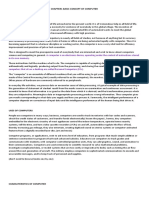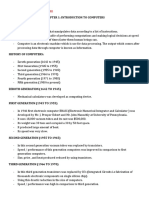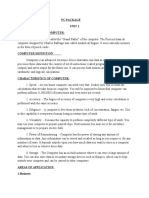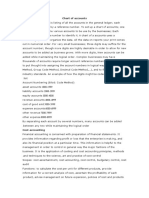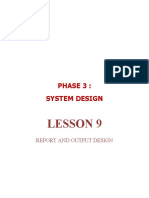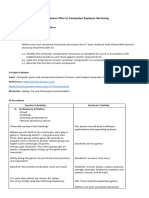INTRODUCTION TO COMPUTER
What is fed in the computer is called data (raw facts and figures e.g., 1+1 data) information is
the already processed.
The definition of a computer can be viewed as illustrated bellow.
Definition of a computer
a) A computer is an information processing machine
b) An electronic device that works under stored programs, accepting, manipulating data
and instruction
Input Process Output
Data and instruction Execution and Storage Information/Result of processing
Qualities of Computer
1. It’s automatic I.e., it can work without human intervention once supplied with data
2. It’s a data processor. This means, it processes raw facts and figures to produce
information.
3. It’s storage device. This means, it’s stores information for later use.
4. Its electrical i.e., requires some sort of power to drive it.
Advantages of computer
Stores large chunks of information in limited space.
1. Speed-performs tasks very fast.
2. Consistency-Gives the same results given the same instructions.
3. Secrecy-information is fairly protected if the computer system is well managed.
4. Versatility –can do the same thing over and over again without being worn out.
5. Computer can work under hostile environment e.g., volcanic eruption.
Disadvantages of computer
1. They are expensive
2. Cut down employment opportunities
3. Need expenses, which is expensive to hire and maintain.
4. Can lead to lose of information if not well managed.
5. Requires a lot of skills.
6. Computers are health hazards
APPLICATION OF COMPUTERS
1. Industry and commerce
✓ Computers are used in day-to-day operations in most companies and industries.
✓ Are normally used in keeping track of orders and bills (transactions) in
companies and industries.
✓ play a major role in business by defining new products and services hence
giving new opportunities for management control.
2. Communication
✓ Digital communication using computers is popular and is being adopted
worldwide as opposing analogue communication using the telephoning system.
✓ Computers have enhanced communication through E-mail communication,
electronic and internet.
0
�3. Education and reference
✓ In computer incorporate databases that are useful in managing educational
resources
✓ The internet has massive reverence material on almost every learning area.
✓ Computer system have enabled efficient running of libraries for information
storage and retrieval.
4. Entertainment
✓ Computer support high quality motion pictures and music files using high speed and
efficient digital storage device CDS, DVDS, VCDS
✓ The internet provides great entertainment resources e.g., games which have become a
major source of amusement in special places.
5. Health care and medicine
✓ Computers are used keep patients record, medical insurance data and performing
medical diagnosis and patient monitoring.
6. Police and Defense
✓ Computers are nowadays use greatly in fighting crimes through computer forensic.
✓ Police are able to enter fingerprints to databases which are automatically analyzed by a
computer.
✓ In defense, computers are used in electronic news gathering, efficient communications,
detecting and tracking radar systems, which are normally, employed in airports,
warning systems and guided missile systems.
The Functions of computer and Information Technology
• Capture: The process of compiling detailed records of activities.
• Processing: The process of converting, analyzing, computing, and synthesizing all forms of
data or information.
➢ Data Processing
➢ Information Processing
➢ Word Processing
➢ Image Processing
➢ Voice Processing
i. Generation: The process of organizing information into a useful form, whether as
numbers, text, sound, or visual image.
ii. Storage and Retrieval: Storage is the computer process of retaining information for
future use.
iii. Retrieval is the process by which a computer locates and copies stored data or
information for further processing or for transmission to another user.
iv. Transmission: The computer process of distributing information over a
communications network.
✓ Electronic Mail, or E-Mail
✓ Messaging, or Voice Mail
1
� The Importance of Computer Literacy
• Computer literacy
❖ Understand capabilities and limitations of computers
❖ Know how to use safely and efficiently
❖ Avoiding hackers and viruses
❖ Protecting your privacy
❖ Understanding the real risks
❖ Using the web wisely
❖ Avoiding online annoyances
❖ Ability to maintain, upgrade, and troubleshoot a computer
❖ Keeping up to date
COMPONENTS OF ACOMPUTER
A typical personal computer has components to enter data (keyboard and mouse) to
displayed and print information (monitor print), retrieve and store information (CD-ROM
and disk drives); and communicate with other computers (modern).
The basic components of the computer include;
✓ Hardware’s
✓ Software’s
✓ Human ware/or ware
Hardware’s-
These are all physical tangible parts of the computer systems. They include all
input, processing output and storage computer system
Categories of hard ware
1.Input devices
2.Output devices
3.Processing device
4.storage device
Input Device
These are devices that allow the user to enter data into the computer system. Input devices
include;
1. Keyboard
✓ This is an input device that resembles a typical typewriter which is used to convert human
understandable data into electrical pulses understood by the computer processor.
✓ The keyboard is made up of five different parts i.e., alphanumeric keypad, numeric
keypad, cursor positioning and assist functional keys and operation keys.
2.Mouse
This is an input device which become popular with the emergence of graphical user interfaces
(GUI)
It is a plastic rodent which lies on the table atop of a plastic mat.
It is used to issue commands to the computer by activating certain spots on the computer
screen.
2
�Left mouse button is used to
1. Issue commands
2. Move items
3. Select
4. Highlight (holding down the left mouse button and dragging)
Right mouse button is used to:
1. Retrieve commands
2. Create shortcuts
Other input devices include;
1. Scanner–it is an input device that captures graphical text and drawings into the computer
system. Graphics such as: photograpraphs, drawings and logos can be scanned to the computer
system.
2. Joystick-is an input device that is used to playing games.
3. Light pen
4. Touch pad etc.
OUTPUT DEVICES
This are devices used to provide the user with the results from the computer. They enable the
computer user to get the output from the computer (feedback).
Output devices include;
1 Monitor/screen
It is also called a visual display unit (V.D.U) it is a primary output device
It is screen that typed data appears.
Information displays on the monitor\ screen prior printing is called softcopy
2. These are the output device used to output data in hard copy (touchable i.e., data on the)
printers are normally classified as per the following characteristics.
1. Speed
2. Print quality
3. Cost
Printers can also be classified according to how they print e.g., Impact or non-impact printers.
3. Plotters
A plotter is graphic printer that draws images with ink pens.
They are used to print graphics on larger paper sizes and full-size engineering and
architectural drawings
4. Speakers
PROCESSING DEVISES
These are the devices, which does the actual processing of data.
The CPU is the computer processor. This is where the work of processing is done. This is
where CPU can be described as the computer brain or heart of the computer system. It
monitors all computer operations.
The CPU is made-up of three main components namely;
1.Control unit (CU)
2.Arithmetic logic unit (ALU)
3.Main memory unit (MMU)
3
� Central processing Unit
Arithmetic and Logic Unit (A.L.U)
It forms arithmetic calculations such as multiplication, addition, subtraction &division and
logical comparisons/operation under the
Control Unit (CU)
It is the part of the computer that controls, supervises and oversees all the activities of the
computer system. It interprets under instructions and issues signals so that the hardware
executes them as requested. It manages all processing tasks of the computer.
MAIN MEMORY UNIT
There are two different types of memories in a microcomputer i.e., main
memory & secondary memory.
Main memory-This is used for holding data and instruction required immediately by the
C.P.U.
Types of main memory include;
1.Random Access Memory (RAM)
2.Read Only Memory (ROM)
Random Access Memory
The name Random Access means that, it is the information in any area of the RAM can be
read or accessed in the same amount of time randomly using a technique called algorithm
generated address/mathematical procedure.
4
�Characteristics RAM
1.It is the working area of the computer.
2.It stores data and instruction as awaiting processing.
3.Stores the intermediate result s of computer (computer users through the output unit)
4.It is volatile it loses its contents whenever the memory cells are de-energized or switching
off power therefore the contents must be saved or backups made for future use.
5.It’s read and writes memory –information can be written into it and read from it
6.It makes 70 of the main memory.
Read Only Memory (ROM)
ROM is an acronym for Read Only Memory. The contents of this memory section can be
retrieve/read but cannot be written to it.
The contents of this internal memory cannot be altered.
Characteristics of ROM
1. It provides a permanent and semi-permanent storage i.e.; its contents can be read but cannot
be written during normal computer operations.
2. ROM are used in computer for permanent storage of instruction e.g., those that the
computer use while booting (starting up)
3. It’s a non –volatile type of memory, implying that its contents remain intact even when the
power is switched off.
There are four major types of ROM’s used today namely’’
1.Read Only Memory (ROM)
2.programmable Read Only Memory (PROM)
3.Erasable Programmable Read Only Memory (EPROM)
4.Electrically alterably Read only Memory (EAROM)
STORAGE DEVICES
Secondary /auxiliary storage
This is used to supplement the main /internal memory. It can also be described as backing
storage. The backing storage media are usually used for storing and maintaining data and or
instruction that are not immediately required by the processor.
The media are normally fit into the computer memory.
TYPES OF BACKING STORAGE DEVICES AND MEDIA
1. Hard Disks
❖ This is the main device that the computer uses to store information. Itis also called
hard disc drive or fixed disc drive.
❖ Most computers have one hard disk located inside the computer case and is called
drive
❖ The hard disk /drive, magnetically stores data on stuck of
Rotating disk called platters.
❖ The hard drive has several read, write heads that read data from the disc.
2.Floppy disk /diskettes
They are described as floppy for they are made from plastic base material /which make them
flexible.
1
The most common types of floppy disc are 3 ½ or 54 inch floppy disc.
They are usually installing new programs, transfer data, and back up data.
5
�NOTE; Back up is the process where a copy of a file, folder, or volume is stored on a separate
storage device from the original for the purpose of retrieval incase the
original is accidental erased damaged, or destroyed.
Protecting a floppy disk.
1. You can prevent erasing and recording information on a floppy disc by sliding the tab to the
write protected position.
2. Keep floppy disc away from magnets as they can damage information stored in the disc.
3. Do not store floppy disc in extremely hot or cold location.
4. Do not spill liquids like coffee and soda on the disc.
5. Do not bend the diskettes.
3. CD ROM
C-compact
D-Disc
R-Read
O-only
M-memory
✓ It is used to store information which can only be read but cannot be written.
✓ It can store more than 600 megabytes (MB) of data. This is equivalent to over 400
floppy disc.
Advantages of a CD ROM
✓ The large storage capability makes it store programs for installing to the computer system.
✓ A CD-ROM disk can store a multi-media presentation.
✓ You can play music CDS on a CDROM drive while you work.
✓ There are thousands of education titles, game and encyclopedias on CD ROM disc. The
titles are interactive you can move through topics covered on disc at your own page.
Handling A CD Rom Disc
1. When handling a CD ROM Disc, hold the disc around the edges.
2. When you finish using the disc, make sure you place the disc back on its protective
case.
3. Do not remove the disc or move the computer when the light on the CD ROM drive
is on.
4. Do not scratch the disc surface.
Other storage devices include.
✓ Magnetic discs
✓ Winchester discs
✓ Magnetic tapes
✓ Flash discs
✓ D.V.D ROM discs (Digital Video discs)
SOFTWARE
The term software
Is used to describe the complete range of computer programs that enable the computer, to
work effectively. There are also defined as programs, with step-by-step instruction, that tells
the computer hardware what to do.
Categories of software
1.System software
2.Appication software
6
�SYSTEM SOFTWARE
These are software that controls the computer and enables it to run application software
This system software consists of a set of instructions that enables the proper functioning of
computer hardware.
System software is further sub-divided into two categories
1. Operating system
2. Utility programs
1.OPERATING SYSTEM
➢ These are sets of instructions that interface between the computer hardware and
software.
➢ It consists of a set of programs that manage the basic operation of the computer.
➢ It remains in the memory (Main memory) until the computer is switched off.
➢ Operating system manages all computer resources I.e., input output transfers memory
all location.
➢ and the central processing unit (CPU)
➢ It also ensures the proper orderly and efficient use of hardware by application
programs.
FUNCTIONS OF THE OPERATING SYSTEM
1. Scheduling and loading of programs to provide a continuous job processing
sequence or to provide appropriate responses to event.
2. Handling of errors when they occur and using corrective routines where possible.
3. Passing of control from one program to another under a system of priority when
more than one application program occupies main storage.
4. Protecting hardware’s, software’s and data from improper use.
5. Acts as a link between computer hardware and software’s
Examples of operating systems
▪ Windows 95,97,98,2000
▪ Windows.NET
▪ Windows XP
▪ Unix
▪ Novel
▪ Ms-DOS
1. UTILITY PROGRAMS
These are small programs, subprograms or modules that enable the computer to perform
routine jobs. e.g., computer translator, assemblers, compliers debuggers and database
management system. They provide useful service to the computer e.g., repairing disc or
clearing computer virus.
APPLICATION SOFTWARE
This refers to programs or set of instructions that enable the user to solve or perform
his/her own tasks when using a computer i.e., they enable a computer to operate
effectively for a specific or
general task.
7
�CATEGORIES OF APPLICATION SOFTWARE
1. General purpose application software.
2. User programs/tailor-made programs.
General-purpose application software
This is set of fully described or narrated programs, developed to solve particular problems
with little or no alliterations.
Some general-purpose applications or software which are in great use today include;
1.Word processors e.g., Microsoft, word pad, word perfect, word star etc.
2.Spread sheets-letters 1-2-3, sage, excel, etc.
3.Data base packages-e.g., MS-Access, oracle d-base 1&11, SQL
4.Accounting packages –e.g., sage, quick books, etc.
5.Presentation packages-e.g., power point, Ventura etc.
6.Desktop publishing packages e.g., Adobe Page maker, Corel draw etc.
User programs/tailor programs
These are programs develop by users to solve specific processing tasks which suit specific
organization and may not suit other organization needs.
8
� TYPES OF COMPUTERS
1.size and cost
Super computers
These are very expensive, very fast and the most powerful computers .They are mainly used
in scientific applications stations such as nuclear stations and weather forecasting stations .
Support use by many people at the same.
Main frames
They are large and very powerful computer. Support use by many people at the same time.
Process large amounts of data very quickly and therefore used by big companies such as banks
and government.
Mini computers
They are smaller and less powerful than main frames computer. Support a number of
concurrent users but are usually slower than mainframe computers. They are cheaper than
mainframe. They are used as departmental serves in networked firms.
Micro computers (Personal computers)
These are computers with microprocessors. They are smaller than the mini computer. They are
made to fit on desktops for individual persons use. They are mostly used in offices and homes.
They are cheaper than mini computers.
Portable computers
They include laptops note books and palm tops. They are extremely lighter than personal
computers Note book computers typically weigh less than 3kgs and are small enough to fit
easily a briefcase. The main difference between microcomputers & laptops notebooks in their
sizes.
Portable computer also supports a limited number of peripherals compared to microcomputers.
2.Purpose
9
�Digital computers
They are the most commonly used types of computers. Their arithmetic and logical
comparison are based on digits (OS and 1S). They use binary language and can process both
numeric and alphanumeric data. Digital computers can store large chunks of information.
Analog computers
These are computers that performs arithmetic functions and logical comparisons by measuring
physic al changes in physical magnitudes. E.g., pressure changes, temperature change etc.
Example of analog computers include slide rule, car speedometer.
Hybrid computers-combined analog and digital computers capabilities
Types of hybrid computer are;
• General purpose-They are computers designed to be used in a variety of application
environments as required .The ranges of applications they can hand depend on the
volume of data to be processed and the processing power.
• Special purpose-They are designed to special processing task in or more applications
areas. In networked environments a special computer called front-end processor is used for
processing communication tasks only.
COMPUTER VIRUS
A virus is a program designed specifically to damage other programs or cause irregular
behaviors in a computer system.
A virus is designed in such a way that it can amend/destroy programs and data files by
interfering with normal processes of the operating system.
Sources of Virus
1. Contaminated diskettes/storage media-Any diskettes, flash disk or any other storage
media is used on another computer, it introduces a virus to that system.
2. Pirated Software-the use of pirated software introduces risk that they might be
contaminated with the virus.
3. Fake games- one can down load game program which has a viruses
4. Software updates-The internet is a source of most viruses.
Symptoms of computer virus
✓ Unfamiliar graphics or quizzical messages appearing on the screen
✓ Programs taking longer than usual to load
✓ Less memory allowance than usual.
✓ Programs of files mysteriously disappearing
✓ Unusual error messages occurring more frequently
✓ Disk access screening excessive for simple task
A Virus is designed to replicate itself thus crashing the computer.
Security measures against viruses
✓ Avoid using foreign diskettes
✓ Scan all foreign disks using an updated anti-virus program
✓ Identify and discard any affected disks.
✓ Always use passwords to prevent unauthorized access to your computer.
10
� Rules for Computers in Classrooms
Problem: Computers in the classroom can be used
or misused.
What should they be used for?
✓ Following the lecture.
✓ Working along with the instructor.
✓ Performing instructor-assigned Internet searches.
✓ Completing assignments for this class.
What is misuse?
✓ Text messaging or emailing friends
✓ Surfing the Internet for entertainment
✓ Doing assignments for other classes
11


















